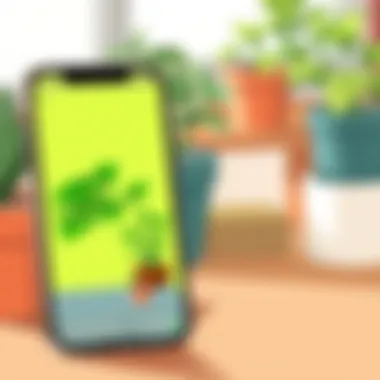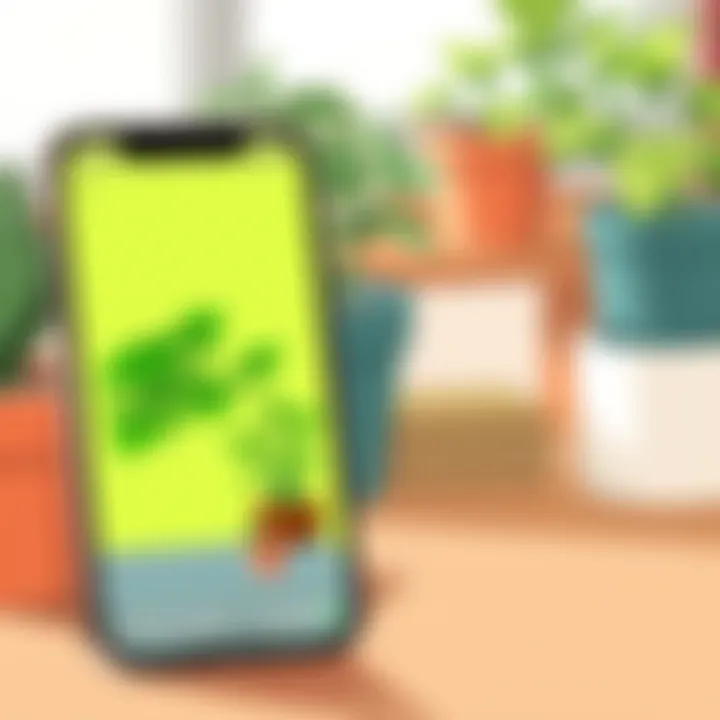Exploring the Smart Plant Home App for Indoor Gardening


Intro
In today's world, where technology finds its way into every nook and cranny of our daily lives, the intersection of mobile apps and horticulture is gaining traction. Enter the Smart Plant Home App, a tool that melds innovation with a green thumb. This app isn't just a digital notebook for plant care; it astonishes with its comprehensive features, bridging the gap between nature and technology. For both novice plant parents and skilled botanists, understanding this app opens doors to easier plant management while ensuring sustainability.
Software Overview
Software Features
The Smart Plant Home App thrives on its unique abilities, making it a standout choice among gardening enthusiasts. Users can expect:
- Personalized Plant Care Guides: Users input their plants' types, and the app tailors advice specific to them. With everything from watering schedules to fertilization tips, it takes on the guesswork of plant care.
- Plant Identification: A handy feature that uses a photo to identify species within moments. Gone are the days of being unsure about what sits in your pot.
- Pest and Disease Detection: Users can capture images of ailing plants. The app swiftly analyzes the photos, offering insights into potential pests or diseases.
- Garden Journal: This feature allows users to track growth progress and care routines, helping gardeners document their journey with each plant.
Technical Specifications
The Smart Plant Home App evolves continuously to meet user needs. Here’s what supports its well-oiled machine:
- Compatibility: Available on both Android and iOS devices, the app assumes a universal reach for users.
- User Interface: The design leans toward simplicity, ensuring that even less tech-savvy individuals can navigate seamlessly.
- Data Storage: Cloud-based storage is employed, preserving users' data securely while allowing access from multiple devices.
"Integrating a gardening app into your plant care routine isn’t just about convenience; it's fundamentally changing how we engage with our green companions."
Peer Insights
User Experiences
Diving into users' feedback showcases the app's practicality. Many users expressed a sense of empowerment from enhanced knowledge about their plants. A community exists, sharing their experiences on platforms like Reddit and gardening forums.
Pros and Cons
Every tech venture comes with its own set of strengths and challenges:
Pros:
- Improved plant growth and health
- Easy sharing options with friends
- Continuous updates based on user feedback
Cons:
- Occasional app glitches reported
- Users may find features overwhelming initially
Prolusion to Smart Plant Home Apps
The world of plant care has experienced a metamorphosis, thanks largely to the advent of smart technology. The Smart Plant Home App showcases this transformation by streamlining the process of nurturing plants, an endeavor that traditionally demanded a hefty amount of time, expertise, and attention. In a fast-paced society where gardeners might juggle careers and family commitments, this app caters to both the casual green thumb and the ardent horticulturist. Understanding the importance of smart plant home apps becomes pivotal as we delve deeper into this digital age of horticulture, exploring how such applications enhance our engagement with nature within the confines of our homes.
The purpose of a smart plant home app, as the name suggests, is to merge tech-savvy solutions with age-old plant care practices. At its core, the app aims to make plant care more accessible and individualized. The features it encompasses provide users with tailored guidance based on their specific plants, allowing them to cultivate their indoor gardens with confidence, regardless of their prior experience.
Definition and Purpose
Smart Plant Home Apps are mobile applications designed to assist users in managing their indoor plants effectively. They leverage technology to provide tools for plant identification, watering schedules, and nutritional needs. Fundamentally, they exist to bridge the gap between users and their plants, alleviating common frustrations associated with plant care, like overwatering or nutritional deficiencies.
The purpose of these apps can be dissected into several key components:
- User Education: They serve as educational resources, guiding users on best practices for plant care, which is especially beneficial for novices.
- Personalized Monitoring: By allowing users to input their specific plants, the app tailors reminders and care tips, helping to mitigate the guesswork involved in maintenance.
- Community Engagement: Many of these applications foster a sense of community by connecting users to discussion forums or expert advice, allowing valuable interactions and insights to flourish.
Historical Context of Plant Care Technology
The journey to the modern smart plant home app extends back decades, intertwining with the evolution of both gardening and technology. The initial foray into plant care technology began modestly with guides and manuals that helped gardeners understand the essentials, from soil types to pest management.
With the digital revolution, the landscape began to shift dramatically. The introduction of personal computers in the 1980s opened the floodgates for software that could support various horticultural activities, albeit primarily for agricultural use. Fast forward to the early 2000s, the rise of smartphones ushered in a new era. Gardening apps began popping up, incorporating features such as photo-sharing and community forums. These apps aimed to make gardening more social and interactive, but they lacked the intuitive design and tailored approaches that modern apps promote.
By the 2010s, a more sophisticated understanding of user experience paired with advanced algorithms allowed for the creation of apps that not only provided basic information but also harnessed data analytics to yield insights about plant health and care requirements. This was coupled with the increasing interest in sustainable living, which pushed developers to embed eco-friendly tips and practices within these applications.
Thus, the Smart Plant Home App stands not just as a tool for convenience, but as the culmination of years of technological advancement and a growing appreciation for the environment. The evolution of plant care technology reflects a deepening relationship between humans and nature, facilitated by innovative solutions that nurture our botanical companions.
Core Features of the Smart Plant Home App


The core features of the Smart Plant Home App shine as essential components that cater to the diverse needs of its users. This section will dive deep into individual aspects of the app's functionality. Understanding these core features helps users grasp how technology can simplify plant care and enhance their gardening experience. For both novices and seasoned gardeners, these elements bring clarity, guidance, and assistance in nurturing their green companions.
Plant Identification Tools
The plant identification tool stands out as a pivotal feature of the Smart Plant Home App. It allows users to photograph their plants and receive immediate feedback on the species. This capability can prove invaluable, especially for those struggling to discern between various plant types or uncertain about their care needs. By incorporating advanced image recognition technology, the app can provide users with accurate identification within moments.
The tool can also link you to a wealth of information regarding the specific plant you have. For instance, after capturing that picture of your stubbornly wilting succulent, you'll find not just its name but also tailored care instructions specific to its species. This fosters a better understanding of plants and promotes healthier growth habits. Also, let’s not forget about the community aspect. Users can share their plant photos, helping others identify similar varieties or even find solutions for plant ailments through shared experiences.
"Plant identification tools do not just help you name your plants. They cultivate a sense of belonging among gardeners, fostering a community of shared knowledge."
Watering and Care Notifications
Another hallmark feature of the Smart Plant Home App lies in its watering and care notifications. It's not just about setting a standard reminder; the app takes into account various factors that affect watering schedules. Users can input specific details about their plants, such as species, pot size, and environmental conditions. From there, the app provides automated notifications that align with the watering needs of each plant.
Imagine being a busy professional or parent. You might not have the time to remember which plant gets watered on what day. With smart notifications, the app serves as your personal gardening assistant. It’s like having a reliable friend who nudges you with gentle reminders, ensuring you don’t miss a watering or care session.
Moreover, these notifications extend beyond just watering; they also encompass other critical care aspects like fertilizing or repotting. This holistic approach saves users time and fosters plant health.
Growing Insights and Analytics
The last crucial piece of the Smart Plant Home App’s core features is its provision of growing insights and analytics. This feature transforms gardening into a data-driven endeavor. Users can track their plants’ growth cycles, monitor environmental conditions, and even analyze their care routines to ascertain what works best.
This analytical depth is a boon for understanding plant behavior. It enables users to reflect on which treatments yield the best results, fostering a cycle of continuous improvement.
- For example, if you notice your fern is thriving more in brighter light conditions, you can adjust your care practices accordingly.
- Alternatively, if a particular watering schedule leads to better growth, documenting this can help refine your approach.
These insights not only bolster user satisfaction but also encourage a scientific approach to plant care, blending tech with tradition in a seamless manner.
User Interface and Experience Design
User interface and experience design play a crucial role in the usability of the Smart Plant Home App. An effective UI/UX design structure fosters a positive relationship between users and the application, which not only enhances engagement but also ensures the app meets the diverse needs of its audience. For users who may not be tech-savvy, a well-designed interface can be the bridge that connects them with advanced plant care technology, making horticulture less intimidating and more accessible.
Navigational Efficiency
Navigational efficiency in the Smart Plant Home App is vital. Users expect to jump right in—no convoluted menus or hidden features. The app prioritizes intuitive pathways; everything is where you might naturally look for it. This strategy helps avoid a maze-like experience that can frustrate even the most patient animal. Consider, for instance, the plant identification tool that's usually front and center, enabling quick access without fumbling around through multiple screens. Some may equate excellent navigation with speed, while others may lean more toward simplicity. Ultimately, the app strikes a balance, allowing users to find essential functions with minimal effort.
Visual Appeal and Layout
Visual appeal is what first draws users in, but it’s the layout that keeps them around. The Smart Plant Home App employs a clean and uncluttered design. Soft, earthy colors are not just for aesthetics; they reflect the app’s theme and resonate with its user base who have an affinity for nature. Each section is organized logically, with a layout that’s easy on the eyes. Clearly distinguishable sections guide users seamlessly through functionalities like watering schedules, plant care tips, and community features.
- Soft color schemes: They soothe while allowing functionality to take center stage.
- Clear typography: Easy-read fonts help in communication; nothing too fancy, just clear.
- Logical grouping: Related features are clustered together, making retrieval of information logical and stress-free.
Accessibility Features
An often-overlooked element in app development is accessibility. The Smart Plant Home App recognizes this need and has included several features to cater to a diverse user base. For visually impaired users, screen reader compatibility is a priority, ensuring that all textual content is easily interpreted. User options to adjust font sizes accommodate various visual preferences, allowing individuals with differing eyesight levels to engage comfortably. Furthermore, contrast ratios meet recommended standards enhancing the usability for all. This attention to accessibility reflects the philosophy that technology should empower rather than hinder.
In summary, thoughtful user interface and experience design choices ensure that the Smart Plant Home App remains user-friendly, visual appealing, and accessible to all kinds of gardeners—from tech novices to green-thumbed enthusiasts. This balance may very well dictate the success of an app in an increasingly crowded marketplace.
Integration with Smart Home Devices
The integration of smart home devices with the Smart Plant Home App is not just an added perk; it’s a substantial enhancement to the overall plant care experience. This capacity to embed plant care into the familiar ecosystem of smart home technology provides numerous benefits—a seamless approach to managing indoor gardening that combines convenience with efficiency.
Compatibility with IoT Devices
At the core of this integration lies the compatibility between the Smart Plant Home App and a multitude of Internet of Things (IoT) devices. Users can easily connect the app with devices like smart light bulbs, moisture sensors, or automatic watering systems. This interoperability enables a holistic view of plant health and care management through a single platform. Here are some notable examples of IoT devices that find common ground with the app:
- Smart Thermostats: These can adjust indoor temperature based on the needs of specific plants.
- Smart Soil Sensors: They provide real-time data on soil moisture and nutrient levels, feeding this information directly into the app for analysis.
- Wi-Fi-Enabled Watering Systems: Scheduling watering sessions can take mere moments, all while sights are set on the bigger picture of plant growth.
By utilizing these devices, plant owners can fine-tune their care routines to the precise preferences of each species they grow, ensuring optimal conditions at all times.
Automated Gardening Solutions
Another fascinating frontier that emerges from this integration is the rise of automated gardening solutions. The Smart Plant Home App acts as a central hub, processing data and facilitating communication between various smart devices. This interconnectedness transforms the gardening experience into something almost futuristic.
For instance, consider an automated watering setup that initiates watering based on sensor data. If a moisture sensor detects dry soil, it will signal the watering system to activate, ensuring plants receive just the right amount of water. This kind of automation not only conserves water but also minimizes the risk of overwatering—a common pitfall for many growers.


Moreover, the app can push notifications to users indicating when certain tasks need to be performed or alert them to changes in environmental conditions that could affect their plants. Combining these features leads to a self-sustaining ecosystem right in one's home.
In summary, the integration with smart home devices significantly elevates the functionalities of the Smart Plant Home App, catering to a wide variety of users, from novices to seasoned gardeners. By allowing compatibility with various IoT devices and providing automated gardening solutions, the app streamlines plant care to be as intuitive and efficient as possible. Choosing to embrace this technology means joining a community of forward-thinking plant enthusiasts eager to cultivate plants in a smart, sustainable manner.
Benefits for Different User Categories
Considering that plant care increasingly incorporates technology, understanding the diverse benefits of the Smart Plant Home App becomes crucial. This app caters to different user categories, from novice gardeners eager to nurture their first plant to seasoned horticulturists seeking to refine their practices. Each category holds unique needs and expectations, and the app uniquely addresses these through tailored functionalities and insights.
Novice Gardener Insights
For those just starting their green journey, the Smart Plant Home App opens a door to knowledge that was once gated behind layers of experience. It provides straightforward plant identification features, making even the most unfamiliar species easier to recognize and care for. The app often includes picture guides and care tips, turning what could be a daunting task into an enjoyable adventure.
Many new gardeners may feel overwhelmed by conflicting information regarding plant care. Here, the app helps to clarify confusion by delivering tailored advice based on specific plant types and local conditions.
When it comes to watering schedules, the app sends reminders, so no one drowns their beloved plant or allows it to dry out completely. This supportive approach instills confidence in beginners, as they can access valuable information at their fingertips without wading through endless online content.
Sustainability and Environmental Considerations
In today’s rapidly evolving world, understanding the importance of sustainability is more crucial than ever. The Smart Plant Home App plays a significant role in this regard, encouraging users to adopt environmentally-friendly practices in managing their indoor gardens. By offering tools that enhance water efficiency and promote biodiversity, the app aligns with broader strategies for sustainable living while fostering a deeper connection between individuals and the natural world.
Water Conservation Techniques
One of the biggest challenges in gardening is ensuring that plants receive the optimal amount of water without wastage. Users can utilize the Smart Plant Home App's advanced watering reminders as it factors in the plant species, local climate, and seasonal changes, enabling precise watering schedules. This not only conserves water but also reduces the risk of over and under-watering, both of which can severely impact plant health.
- Drip irrigation guidance: The app offers tips on installing and optimizing drip irrigation systems, significantly cutting water usage compared to traditional watering methods.
- Weather integration features: By syncing with local weather forecasts, the app can alert users about rain, prompting them to postpone watering and utilize natural precipitation instead.
Implementing these techniques helps homeowners maintain healthy plants while being mindful of water resources—after all, every drop counts. Additionally, the app can provide insights on water-efficient plant species, guiding users towards more sustainable choices in their gardening endeavors.
Promoting Biodiversity
Another highlight of the Smart Plant Home App is its commitment to promoting biodiversity. As urbanization progresses, the habitats of numerous plant and insect species dwindle, leading to ecological imbalances. The app encourages users to cultivate a variety of plant species which in turn, supports a more diverse ecosystem.
- Plant recommendations: The app can suggest plants that are native or complementary to one another, creating a more resilient ecosystem.
- Creating habitats: By highlighting the benefits of including flowering plants that attract pollinators and beneficial insects, users can create their own biodiverse micro-habitats.
By fostering these practices, users can contribute to the restoration of ecological balance, even within their own homes. Greater biodiversity not only supports local wildlife but also enhances plant health, resulting in more robust garden yields.
"The future of gardening is not just about growing plants, but about nurturing ecosystems that sustain life itself."
The Smart Plant Home App emerges as a valuable tool, guiding users via innovative technologies towards a greener, more sustainable future. It embodies the belief that even individual actions can have a significant impact when it comes to promoting environmental well-being.
Community and Support Systems
The realm of plant care, as facilitated by the Smart Plant Home App, thrives on community engagement and user support. This aspect serves as a backbone, promoting knowledge-sharing among users and creating a nurturing environment for both new and seasoned gardeners. Community involvement can aid in troubleshooting issues, sharing tips, and fostering collaboration, thereby enhancing the overall user experience of the app.
User Feedback and Interaction
Engaging with users isn’t just a formality; it’s a vital component that drives the evolution of the Smart Plant Home App. User feedback plays a significant role in tailoring features and enhancing the app's usability. When users can easily share their experiences and suggestions, developers can iterate on features that matter most to them.
For instance, a user might report that watering notifications are occasionally misaligned with their plants' needs. This feedback, once addressed, can lead to a more refined algorithm that better suits various plant species and their specific care requirements.
The interactions within the community can take many forms:
- Forums and Discussion Boards: These platforms are where users can voice their concerns or experiences, allowing for communal support and a wealth of collective knowledge.
- Social Media Groups: Groups on platforms like Facebook or Reddit offer avenues for informal sharing of ideas, images, and advice, thus creating a sense of belonging among plant enthusiasts.
- Surveys and Polls: These tools not only gather feedback but also involve users in the decision-making process.
Through continuous feedback loops, the app cultivates a responsive interface and features that evolve alongside its user base, informing its development trajectory.
Accessing Expert Advice
In addition to peer support, the Smart Plant Home App emphasizes the importance of professional guidance. Accessing expert advice can significantly elevate a user's gardening experience. Whether it’s about recognizing pests or understanding nutrient deficiencies, expert insights can clarify complex issues that users encounter.
Key features to consider include:
- In-App Consultations: Users may have the option to connect with horticulturists directly through the app, which simplifies acquiring specialized knowledge.
- Resource Libraries: Incorporating extensive libraries with articles, videos, and case studies from recognized experts can empower users through education.
- Webinars and Live Q&A Sessions: Hosting these events in the app or through affiliated platforms enables users to interact directly with industry professionals, gaining real-time advice and insights.


This fusion of community engagement and expert access not only enhances the growth experience for users but also transforms the app into a vibrant ecosystem for learning and support, driving sustainable practices and responsible gardening culture.
"A strong community can bridge gaps in knowledge and inspire confidence in even the newest gardener."
Challenges and Limitations
In examining the Smart Plant Home App, it becomes imperative to address the challenges and limitations inherent in its use. While this technology greatly enhances the art of indoor gardening, understanding these hurdles can help users make informed decisions. Recognizing both the barriers and the adaptability of the app fosters a more profound appreciation for its benefits. Without knowing what difficulties may arise, users—ranging from new initiates to seasoned horticulturists—might find themselves at a disadvantage.
Technical Barriers
The integration of the Smart Plant Home App into everyday life is not without its technical hurdles. First off, device compatibility can be a stumbling block. Users with older smartphones may discover that their devices lack the necessary hardware to run the app smoothly. Additionally, certain features—like plant health diagnostics—may rely on advanced sensors or connectivity capabilities not found in every smartphone.
Here’s a glimpse of the potential technical barriers:
- Software Requirements: The app often needs the latest software updates, which some users may overlook or find inconvenient to install.
- Internet Connectivity: A constant and reliable internet connection is vital for features like cloud-based plant analytics or accessing community advice. Users in areas with spotty internet access might face challenges.
- Device Updates: Required updates can disrupt user experience, particularly for those who may delay upgrading their devices or app versions.
Let’s not forget about user interface issues that may not translate well across different devices. Users with various screen sizes or those using older operating systems may experience cropped images or disrupted layouts, which can hinder the overall experience.
User Adoption Hurdles
As beneficial as the Smart Plant Home App can be, convincing individuals to adopt a new technology can prove to be a tough sell. For one, not everyone possesses a tech-savvy mindset. There are those who feel overwhelmed by the app’s offerings, potentially steering them away from using it altogether.
Several challenges are often noted in terms of user adoption:
- Learning Curve: The app may feature an extensive range of functionalities that can intimidate new users. It’s not always straightforward to figure out how to use it effectively without proper guidance.
- Perceived Complexity: Users may often perceive smart gardening solutions as complicated or unnecessary. This leads to resistance, particularly among older generations who may prefer traditional methods over technology.
- Skepticism About Technology: Some individuals might not trust the accuracy of the app's plant diagnostics or notifications. A lingering hesitation can lead to underutilization of features designed to aid plant care.
Despite these barriers, understanding and addressing them can encourage more users to transition into adopting the Smart Plant Home App. Educational resources, user-friendly tutorials, and community support can mitigate these issues, paving the way for a more seamless introduction to tech-enhanced gardening.
"The challenge is not the technology itself; it's the mindset that often shrouds it. To embrace innovation is to embrace growth."
In summary, while the Smart Plant Home App presents a wealth of opportunities for enhanced plant care, users must navigate a range of technical and adoption challenges. Addressing these obstacles is key to unlocking the full potential of this innovative application.
Future Trends in Plant Care Applications
As technology wades deeper into everyday life, it's no wonder that plant care apps are on the cusp of a significant transformation. The importance of exploring the future trends in plant care applications lies not only in enhancing user engagement but also in harnessing the potential of technological advancements to create more efficient and sustainable gardening practices. By understanding these trends, both IT professionals and business stakeholders can identify opportunities to innovate and improve the tools that empower users to nurture their green companions effectively.
Emerging Technologies
In the realm of plant care, emerging technologies are likely to redefine the experience for users across the board. For instance, advancements in artificial intelligence (AI) and machine learning are making their mark. These technologies can analyze plant care data and offer customized advice, tailored insights, and predictive growth patterns. Imagine an app providing notifications precisely when to water or fertilize specific plants based on local weather forecasts or soil conditions; that is not far off.
Moreover, augmented reality (AR) could begin to play an increasingly responsive role. Picture this: standing in your living room with your smartphone, and through its camera, you can visualize how a plant would look in a certain corner. Not only does this elevate user decision-making but it also makes the gardening process more interactive.
Another promising avenue is the integration of sensor technology. Smart sensors can measure soil moisture, light levels, and even nutrient content, transmitting this information directly to plant care apps in real time. Users would benefit from accurate data at their fingertips, fostering a more responsive approach to plant management.
Expanding User Communities
As the landscape of plant care continues to evolve, the aspects of community and shared knowledge can't be overlooked. Expanding user communities are set to become a vital component. By fostering platforms where users can share experiences, insights, and even challenges, these applications can create a rich tapestry of shared goals and collective learning.
The social component could also see a transformation with features that allow users to participate in challenges or collaborative gardening projects. For instance, a user might join a virtual gardening club within the app, allowing them to receive tips from others who are caring for the same type of plants or plants suited to similar climates.
Furthermore, integrating social elements could extend beyond just networking. Users could rate the effectiveness of shared tips or resources, generating a more robust community knowledge base over time.
Additionally, educators and institutions might leverage these communities as a resource for curriculum development in school gardening programs or community workshops, enriching the user experience and broadening the reach of plant care apps.
"In connecting plant care enthusiasts, we create an ecosystem of knowledge that fosters better practices and strengthens our relationship with plants and nature.”
By delving into these emerging technologies and fostering user communities, plant care applications position themselves at the forefront of innovation, accommodating both the tech-savvy gardener and the novice plant owner. As the future unfolds, keeping an eye on these developments will be crucial for anyone deeply invested in the horticultural mindfulness movement.
Ending
In the realm of modern gardening, the significance of the Smart Plant Home App cannot be overstated. This article has traversed through its multifaceted features and functionalities, aligning technology with the art of plant care. Essentially, the app emerges as a vital tool, weaving together the threads of horticulture and advanced technology, culminating in a user-centric experience.
Summary of Key Points
Throughout our exploration, several key points have emerged:
- The core features such as plant identification, watering notifications, and growing insights equip users with an arsenal of knowledge to foster healthy plants.
- A user-friendly interface ensures a smooth navigational experience, making it accessible for all, from novices to seasoned pros.
- The integration with various smart home devices enhances the gardening experience by automating routine tasks and ensuring optimal care conditions.
- Community interactions and access to expert advice foster a support network, encouraging knowledge sharing and growth among users.
- Lastly, the app's emphasis on sustainability aligns well with contemporary environmental practices, promoting water conservation and biodiversity.
Final Thoughts on Technology in Plant Care
The advent of technology in personal plant care represents a transformative shift in how we understand and interact with nature. With applications like the Smart Plant Home App, users gain insights that were previously only available to experienced horticulturists or botanists. This democratization of knowledge empowers average individuals to nurture plants effectively, thereby fostering a deeper connection with the environment. As technologies continue to evolve, the future will likely bring even more innovative solutions that support sustainable practices while engaging the community in meaningful ways.







